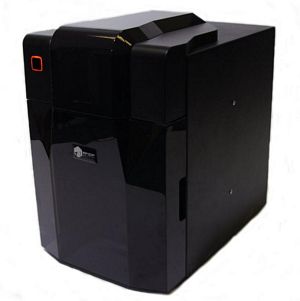
The UP! Mini 3D printer is perfectly designed to generate compact prints with precision and fidelity. As the name suggests, it’s small enough to fit on a cramped desktop, which is a real relief when compared to some of its bulkier competitors like the Ultimaker and Lulzbot. It looks clean and professional with a smooth metal exterior. The Mini resembles a modern espresso machine more than a 3D printer. The downside of its compactness is that it can only print objects up to 4.7 x 4.7 x 4.7 inches, which limits the kinds of designs it can make. There will always be trade-offs with any new technology, and small object size is downside of the Mini.
The Mini is as easy to use as a simple ink printer: plug it in, hook it up to your computer, upload your design and you’re in business. Unlike its more complicated competitors, it doesn’t come as a kit: it’s ready to go right out of the box. It is an efficient but slow 3D printer. The top printing speed is just 3-30 mm per second, depending on the complexity of the object. That puts it very much at the slow end of modern 3D printers, which, let’s face it, have never been very fast at all. If you have a lot of patience and not a lot of space, the Mini may be just the thing for you.
On the plus side, of course, the Mini is whisper quiet. It can run all day and night without the grinding noise of some its bigger brothers in the world of 3D printer. The resolution and precision compares pretty nicely with its bigger competitors. The smallest layer height is 0.2 mm, which is about average for most 3D printers available on the market today. With that layer height, you can print out most of the designs available out there, but don’t expect to be able to reproduce the Eiffel Tower in full detail.
Up Mini! vs Dremel Idea Builder
[table id=9 /]
There is a serious upshot to the Mini in addition to its compact design. It is compatible with both ABS (Acrylonitrile butadiene) and PLA (Polylactic acid), the two most common thermoplastics for 3D printers. Simply swap out the injection cartridge and you can print designs using either ABS or PLA. This is a real advantage because sometimes designs will only come out right in one or the other. Unfortunately, it only has only one print head so you won’t be able to generate multicolor prints.
The Mini’s housing is made out of solid metal, is durable and incorporates some of the best features of modern 3D printing technology. The printing enclosure is fully sealed and the platform is heated to keep prints from warping from environmental humidity and temperature changes during the printing process. The sealed enclosure also protects you, the operator, from burns during the printing process. This will definitely be appreciated by veteran 3D printer users.
The Mini also supports many different ways to send your print designs: email, phone and even blog-based uploads. There is a vibrant user community to help troubleshoot any issues you may have. Whatever problems occur, there are thousands of users to help to overcome. The manual is comprehensive and will help new users get up and running in no time.
In sum, the UP! Mini is small, slow, safe, quiet and very versatile, compatible with all kinds of CAD programs and both ABS and PLA. It is simple to use, easy to maintain and a great way to get started with 3D printers or as a prototyper for your larger and more sophisticated models.

This is one of the cheapest 3d printers on the market so didn’t expect a lot from it. I have a couple of other machines but I was falling behind on my orders and needed something for smaller prints and decided on UP! Mini because of the price. This is actually a very good 3d printer with some small issues. First of all the software that comes with the printer is not very good, especially when compared to Makerbot Makerware. Also, the print bed has a thermostat for 55 degrees only. I had to replace it with a 100-degree thermostat to be able to print with ABS. Other than it has been a great printer for me. The prints come out consistent and look beautiful. I highly recommend UP! Mini.
I’m a mechanical engineer and I work with large, industrial 3d printers on daily basis. The UP! Mini is a very impressive, little unit and the print quality is outstanding. I’ve used Da Vinci which is another budget-priced printer and the Mini’s prints are much better quality than Da Vinci.
The manual that comes with the printer is not very clear so you have to watch the youtube video before you attempt to set it up. It’s actually very easy once you see the video. Make sure you adjust the nozzle height otherwise the print head might crush into the platform and cause damage. Other than that the printer is very to use, a true consumer grade 3d printer, great for a novice like myself.